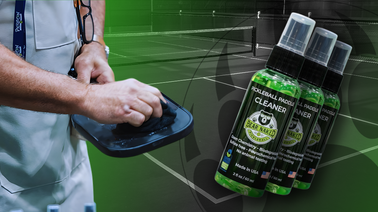
The way you fuel yourself before, during and after pickleball sessions dictates how quickly and effectively your body recovers.
Athletes know peak performance comes from maintaining a lifestyle that is conducive to their goals. Yet, far too many athletes treat their nutrition as an afterthought, especially those that think they are not “athletes” because they play pickleball just for fun.
If you play pickleball, then you can still call yourself an athlete; and if you want to improve your skills on the court, then you need to improve your skills in the kitchen.
It is easy to come up with excuses as to why you eat foods that aren't conducive to your goals, such as not having enough time to prepare your own meals. However, if you are committed to playing pickleball in the long term recreationally or competitively, you need to prioritize your nutrition and health.
If you take control of your nutrition, then you will experience less aches and pains, faster recovery, and better performance both on and off the court. Consider the following tips before you head out to the grocery store.
1. Prioritize Your Protein
Protein provides the building blocks that allow your body to repair and rebuild skeletal muscle and connective tissues after playing pickleball.
I recommend bulk cooking your favorite protein(s) such as: chicken, salmon, beef, shrimp, turkey, etc. Separate the protein(s) into your nutritionist-recommended serving size per meal.
2. Prepare Your Vegetables
Vegetables are rich in antioxidants and other nutrients that protect against cell damage and lower inflammation throughout the body, including in your joints.
When choosing vegetables, remember the more color the better, and variety is key. Prepare vegetables in advance to make incorporating them into your meals easier.
Wash, chop, slice, or dice them and store them in separate containers so that they are readily available to be incorporated while cooking and your already-prepared meals.
You are more likely to use them if they are already prepared and ready to go. Great examples include chopping or dicing onions, peppers, broccoli, and carrots to add to meals and or slice up cucumbers, carrots, or celery to add to salads and/or use to dip into hummus or guacamole.
Pan roasting many different vegetables all at once allows you to load up on a large quantity of vegetables that can last a full week. For example, roast Brussel sprouts, cauliflower, squashes, sweet potatoes, broccoli, onions, etc. Then you can add them as side dishes, onto salads, in marinara dishes, into rice or quinoa, soups, chili, and much more all week long.
3. Grease your joints
Healthy omega-3 fats that are found in cold-water fish, such as wild salmon, trout and sardines and seeds such as flax, hemp and chia are known to fight inflammation in your joints and tissues.
On the other hand, most people are consuming far too many unhealthy omega-6 fatty acids which is abundant in processed foods, fried foods, restaurant cooking oils, peanuts, and soy. You should always avoid those unhealthy fats.
4. Fuel up and reduce inflammation with nature’s dessert
Fruits contain an abundance of anti-inflammatory compounds. Eating fruits that are locally grown provide more nutrients since fresh produce loses nutrients the longer they are sitting around on the shelf.
One strategy is to eat fruit that is in season. Fruits are rich in vitamin C which can also help reduce muscle soreness.
So, throw an apple or orange in your pickleball bag.
Remember, the longer you spend “in the kitchen”, the more you can focus on staying “out of the kitchen,” being healthier and playing better Pickleball.
Cara Zaller is a licensed nutritionist. You can learn more about achieving the right nutrition for you with Cara Zaller, Fuel4U.









